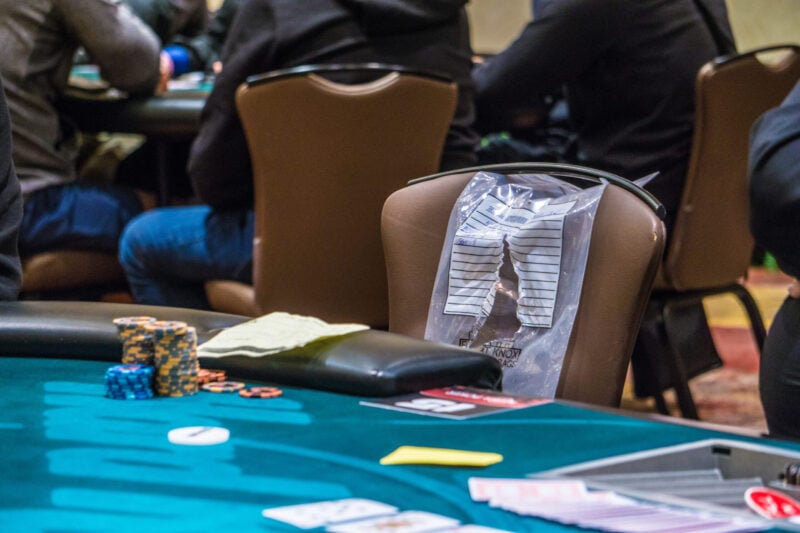I spent my last session in a public poker room playing $1/3 No-Limit Hold’em and making some observations of two good players in my game. I watched for about three hours. They were attentive, gave off few if any tells (that I could notice), were selective, aggressive, and responsive to the pressure of their opponents. They played excellent defense – backing away from fights from time to time – even if they initiated them, and they seemed to have good reading skills.

I was generally impressed with their play – and told myself to generally stay out of their way unless I was loaded.
But, they also seemed possessed of one trait that I saw as a serious liability. It wasn’t of the obvious variety – like playing too many weak starting cards, falling in love with their hands, drawing to hands without sufficient pot odds, or having to look up river bets out of curiosity even when they knew they were beaten. Their problem was strategic, not tactical.
Less is sometimes more
I surmised that they competed too frequently for small pots. They were too busy — too active. While they applied excellent skills to these frequent skirmishes, I think their general combativeness cost them money in the long run. With the 10%, $6 maximum rake, and the $3 drop for the promotions, they were getting their winnings chewed up. Their general approach to the game seemed wrongheaded. And it brought to mind a lesson in non-habitual behavior that I learned not at the poker table but at the bargaining table.
An experience in non-habitual behavior
I’ve been a union negotiator for 40 years. I pride myself on being an excellent one, and I’m especially well-schooled in bargaining within the crucible of battle to organize a large public fight in support of the negotiations and put pressure on the other side. Even so, in an effort to improve my skills, I attended a training meant to teach a different method of bargaining focused more on cooperation than on confrontation. It’s called Interest-Based Bargaining – or IBB for short.
Arm wrestling for fun and profit
There were roughly 30 of us assembled for this IBB training – 15 from the union and 15 from the employer. We listened to an explanation of IBB, and we had some ice-breakers and exercises designed to get us to dissolve the typical barriers between management and union negotiators.
For one of these exercises, the trainer paired us up with someone roughly our size from the “other side.” We were then told that we would each engage in an arm-wrestling contest. We would have five minutes in which to arm wrestle each other. Whoever won the arm-wrestling contest would get $1 for each victory.
When one contest with our opponent was over, we were to immediately begin another. So, for example, if I won one epic battle with my opponent that lasted the full five minutes, I would get $1. If I won three contests and my opponent two during those five minutes, I would get $3 and my opponent would get $2.
We started. For the first 15 seconds or so, everyone was locked in intense battle, trying our darnedest to overpower our opponent and collect the $1 for each victory. Then, it occurred to some of us that we were going about this all wrong.
Instead of trying to overpower our opponent in the typical and habitual way we’d do battle, we could better maximize our winnings by cooperating with our opponent. If we moved our arms back and forth quickly, rapidly taking turns winning and losing, we could earn a lot more money than by trying to overpower each other in a competitive battle.
Habitual competitive behavior isn’t always ideal
The lesson learned was that the habitual strategy wasn’t necessarily the more profitable one. In this case, individual victory over our opponent wasn’t nearly as important as maximizing the number of contests we competed in. The way to do that was with cooperation. The faster we cooperated and completed a contest, the more contests would be won, and the more money we would make.
It’s a lesson that takes us back to the poker table …
Why less may be more
My point isn’t to encourage collusion at the table. I strongly believe that poker must be an honest contest between all participants without any cooperation between or among those participating, so don’t draw the wrong lesson and start cheating. My point, rather, is that the most obvious and habitual manner of competition isn’t always the best way to achieve your goal.
Looking back at my poker game with the two good players, I think they erred by competing habitually. They applied their excellent poker skills at nearly every opportunity, no matter how thin their advantage or how small their possible winnings might be. They sought victory in the small pots with the same intensity as they would seek victory in the very large pots.
They did this without first thinking about the broader strategy that should guide them. To use a well-worn aphorism – they missed the forest for the trees. They looked to score many small victories against their opponents when a very different strategy might have proven more profitable in the long run.
How the rake can destroy profits
Here’s a typical hand you might see in a low-stakes No-Limit Hold’em game. The big blind of $3 is raised by a mid-position player to $12. The skilled player in late position 3-bets to $30 to try to limit the field to the initial raiser, with the intent of outplaying him and winning the pot on the flop.
He’s successful and, when his opponent checks the flop, he bets $40, forcing a fold. Our hero wins the pot of $60.
Before he gets the chips, however, the house rakes 10% of it up to the maximum of $6 and then takes out $3 more for the promotions. Our hero tips the dealer $1 and adds $20 to his stack for his effort. That’s a 33.3% tax on his winnings, which is almost an impossible bite to overcome in the course of a long session.
On the other hand, had this good player approached the game with a different strategy, he might find a much more forgiving rake. Let’s say he designed his game not to win lots of relatively small pots, but to stack his opponents. If he looks for opportunities to do that, and is successful in just one hand where he doubles his stack of $500 against a deep-stacked guy whom he trapped, he’ll come out much further ahead in the long run.
Minimizing the rake
When he stacked his opponent and won the $1,000 pot, our hero paid the same $6 maximum rake and the same $3 promotional drop. He was also more generous with his tip, tossing the dealer $3. $12 was gone from his winnings, leaving him $487 to add to his stack.
His “tax” in the hand came to just 2.6% of his winnings, which is a pittance in the long run, and an amount that’s surely beatable.
Conclusion
Just like the arm wrestler in the example above, good poker players need to look at the bigger picture of how they will best maximize their profits. Though they’re capable of pressuring more timid players, and of winning lots of small pots, that may not be the most effective way of ending up with the money.
I’m not suggesting that one can always stack an opponent just because that’s your intent. Even so, a good player in a small-stakes but heavily raked No-Limit Hold’em game, may be better off with a strategy that’s less busy and more strategic, aiming to win many fewer, but much larger pots.


